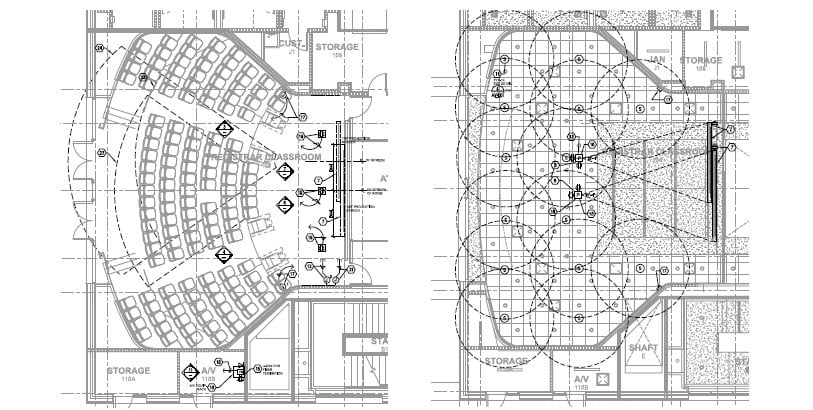Audiovisual (AV) systems have the power to optimize business, revolutionize learning, inspire new marketing techniques, and change the way consumers see a brand. AV technology is breaking new ground around the world and inspiring innovation in numerous industries, from healthcare and retail to education.
As an audiovisual integrator, you can help your clients realize the benefits of technology by designing AV systems that meet their technological, aesthetic, and budgetary needs. End users and decision-makers, IT departments responsible for managing or even installing AV systems, and professional integrators alike can benefit from working with an AV designer to ensure the systems specified are a good fit for the space and the organization.
The Essentials of Great AV Design
There are many factors that affect the mechanical, electrical, and structural aspects of a great AV system. AV design encompasses these requirements, from the placement of the screens and loudspeakers to the control system deployed. Of course, these requirements vary from industry to industry—and even from venue to venue. However, even as these requirements change, the fundamentals of good AV design remain the same across projects.
The First Steps Toward AV Design
Developing AV design for a classroom, business, restaurant, hotel, or retail outlet can be complex. It involves many moving pieces and players to be successful. The first step toward designing your AV system is to draw or acquire the blueprints of the venue, including floor plans and ceiling plans. You’ll also need equipment details, schedules, and risers. Finally, you’ll need technical AV system drawings, showing control system user interfaces and signal flow. Rely on an experienced AV designer or consultant to assemble your drawing package—it’s the most important step toward getting the AV systems right.
Delve into Design: What You Need to Know
An AV system is only as good as its design. Different rooms and usages require different AV designs to work seamlessly for their intended purpose.
Classroom AV design, for example, connects students with remote instructors, introducing them to ideas and people to which they would otherwise not have access. AV systems for the classroom should focus on stimulation, excitement, and engagement, as well as learning and enrichment. The design could include document cameras, electronic whiteboards, and video conferencing technology to connect with global students.
A retail outlet, on the other hand, may require distributed sound systems to create a specific ambiance through music, paging systems for emergencies, and digital signage for branding.
Even with the differences in mind, most AV system designs must take the following into consideration:
- Display size, type, and placement. Calculate the most appropriate screen size for the location and viewing angle. Bigger isn’t always better—match the display to the room’s size and purpose. Keep image resolution in mind, too. As resolution standards move toward 4K and beyond, it may be best to future-proof systems with the highest resolution LED screens or projectors the budget allows. Consider the type of screens that are best for the project as well. Today’s video walls allow for innovative design solutions, while virtual reality and augmented reality technology can take a system to the next level in a higher education or retail environment.
- Assess the project’s audio needs. While the visual aspects of AV design tend to be the most exciting, you can’t forget the “A” in AV. Think about speaker locations, microphones, amplifiers, processing, and the level of audio quality you need, as well as whether the system will be used for music, spoken word, or both.
- Keep power requirements in mind. Hire an experienced AV designer to help you with the location of outlets and power connections to ensure your system will work for your room. Don’t forget power conditioning and power isolation to get the most out of the system and protect the delicate components from power surges and sags.
- Optimize control panels. Great AV systems have easy-to-use control systems for lighting, audio, and video components. If the budget permits, the AV system should include complete automation of the systems, along with remote monitoring. The system should have an intuitive touchscreen user interface for easy adoption, perhaps even with mobile control from a smartphone, iPad or tablet.
- Focus on user needs. Depending on the customer, AV systems should streamline operations, engage learners, enhance communications, or contribute to the branding of an organization. In general, AV should enhance the lives of the users in some way, making tasks more convenient, more enjoyable—or both. Even the most technologically advanced AV systems won’t achieve these goals if the design doesn’t focus on the users’ needs and desires and offer features in a format that’s easy to learn and use. If the intended user can’t operate the system to the potential they need, they will end up frustrated and could potentially stop using the system altogether.
With these elements in mind, you should be able to tailor your AV system to your clients’ exact needs.
Remember, even the most high-quality AV components can offer poor returns for the customer if the equipment isn’t part of a well-conceived and executed design. But with expertly designed AV, you’re in the position to create a connected, collaborative world.



